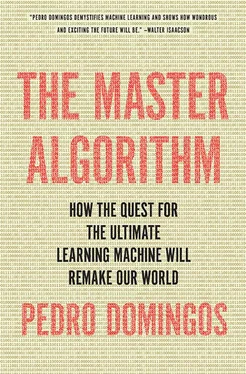The trajectory we’re on is not a singularity but a phase transition. Its critical point-the Turing point-will come when machine learning overtakes the natural variety. Natural learning itself has gone through three phases: evolution, the brain, and culture. Each is a product of the previous one, and each learns faster. Machine learning is the logical next stage of this progression. Computer programs are the fastest replicators on Earth: copying them takes only a fraction of a second. But creating them is slow, if it has to be done by humans. Machine learning removes that bottleneck, leaving a final one: the speed at which humans can absorb change. This too will eventually be removed, but not because we’ll decide to hand things off to our “mind children,” as Hans Moravec calls them, and go gently into the good night. Humans are not a dying twig on the tree of life. On the contrary, we’re about to start branching.
In the same way that culture coevolved with larger brains, we will coevolve with our creations. We always have: humans would be physically different if we had not invented fire or spears. We are Homo technicus as much as Homo sapiens . But a model of the cell of the kind I envisaged in the last chapter will allow something entirely new: computers that design cells based on the parameters we give them, in the same way that silicon compilers design microchips based on their functional specifications. The corresponding DNA can then be synthesized and inserted into a “generic” cell, transforming it into the desired one. Craig Venter, the genome pioneer, has already taken the first steps in this direction. At first we will use this power to fight disease: a new pathogen is identified, the cure is immediately found, and your immune system downloads it from the Internet. Health problems becomes an oxymoron. Then DNA design will let people at last have the body they want, ushering in an age of affordable beauty, in William Gibson’s memorable words. And then Homo technicus will evolve into a myriad different intelligent species, each with its own niche, a whole new biosphere as different from today’s as today’s is from the primordial ocean.
Many people worry that human-directed evolution will permanently split the human race into a class of genetic haves and one of have-nots. This strikes me as a singular failure of imagination. Natural evolution did not result in just two species, one subservient to the other, but in an infinite variety of creatures and intricate ecosystems. Why would artificial evolution, building on it but less constrained, do so?
Like all phase transitions, this one will eventually taper off too. Overcoming a bottleneck does not mean the sky is the limit; it means the next bottleneck is the limit, even if we don’t see it yet. Other transitions will follow, some large, some small, some soon, some not for a long time. But the next thousand years could well be the most amazing in the life of planet Earth.
So now you know the secrets of machine learning. The engine that turns data into knowledge is no longer a black box: you know how the magic happens and what it can and can’t do. You’ve met the complexity monster, the overfitting problem, the curse of dimensionality, and the exploration-exploitation dilemma. You know in broad outline what Google, Facebook, Amazon, and all the rest do with the data you generously give them every day and why they can find stuff for you, filter out spam, and keep improving their offerings. You’ve seen what’s brewing in the world’s machine-learning research labs, and you have a ringside seat to the future they’re helping to bring about. You’ve met the five tribes of machine learning and their master algorithms: symbolists and inverse deduction; connectionists and backpropagation; evolutionaries and genetic algorithms; Bayesians and probabilistic inference; analogizers and support vector machines. And because you’ve traveled over a vast territory, negotiated the border crossings, and climbed the high peaks, you have a better view of the landscape than even many machine learners, who toil daily in the fields. You can see the common themes running through the land like an underground river, and you know how the five master algorithms, superficially so different, are really just five facets of a single universal learner.
But the journey is far from over. We don’t have the Master Algorithm yet, just a glimpse of what it might look like. What if something fundamental is still missing, something all of us in the field, steeped in its history, can’t see? We need new ideas, and ideas that are not just variations on the ones we already have. That’s why I wrote this book: to start you thinking. I teach an evening class on machine learning at the University of Washington. In 2007, soon after the Netflix Prize was announced, I proposed it as one of the class projects. Jeff Howbert, a student in the class, got hooked and continued to work on it after the class was over. He wound up being a member of one of the two winning teams, two years after learning about machine learning for the first time. Now it’s your turn. To learn more about machine learning, check out the section on further readings at the end of the book. Download some data sets from the UCI repository (archive.ics.uci.edu/ml/) and start playing. When you’re ready, check out Kaggle.com, a whole website dedicated to running machine-learning competitions, and pick one or two to enter. Of course, it’ll be more fun if you recruit a friend or two to work with you. If you’re hooked, like Jeff was, and wind up becoming a professional data scientist, welcome to the most fascinating job in the world. If you find yourself dissatisfied with today’s learners, invent new ones-or just do it for fun. My fondest wish is that your reaction to this book will be like my reaction to the first AI book I read, over twenty years ago: there’s so much to do here, I don’t know where to start. If one day you invent the Master Algorithm, please don’t run to the patent office with it. Open-source it. The Master Algorithm is too important to be owned by any one person or organization. Its applications will multiply faster than you can license it. But if you decide instead to do a startup, remember to give a share in it to every man, woman, and child on Earth.
Whether you read this book out of curiosity or professional interest, I hope you will share what you’ve learned with your friends and colleagues. Machine learning touches the lives of every one of us, and it’s up to all of us to decide what we want to do with it. Armed with your new understanding of machine learning, you’re in a much better position to think about issues like privacy and data sharing, the future of work, robot warfare, and the promise and peril of AI; and the more of us have this understanding, the more likely we’ll avoid the pitfalls and find the right paths. That’s the other big reason I wrote this book. The statistician knows that prediction is hard, especially about the future, and the computer scientist knows that the best way to predict the future is to invent it, but the unexamined future is not worth inventing.
Thanks for letting me be your guide. I’d like to give you a parting gift. Newton said that he felt like a boy playing on the seashore, picking up a pebble here and a shell there while the great ocean of truth lay undiscovered before him. Three hundred years later, we’ve gathered an amazing collection of pebbles and shells, but the great undiscovered ocean still stretches into the distance, sparkling with promise. The gift is a boat-machine learning-and it’s time to set sail.
First of all, I thank my companions in scientific adventure: students, collaborators, colleagues, and everyone in the machine-learning community. This is your book as much as mine. I hope you will forgive my many oversimplifications and omissions, and the somewhat fanciful way in which parts of the book are written.
Читать дальше












